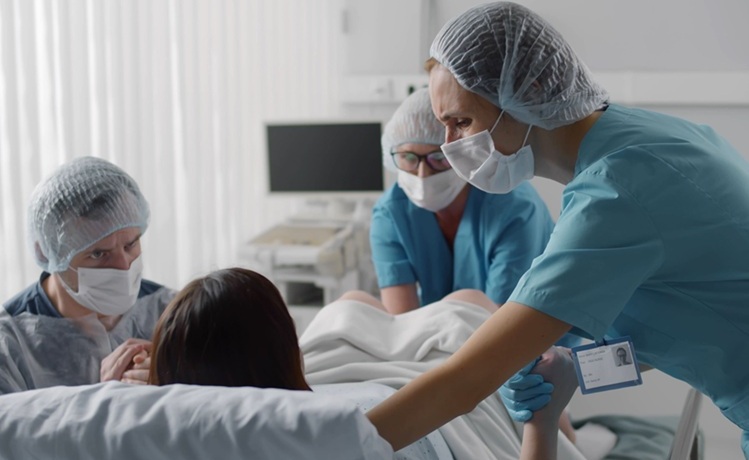Crohn's Disease-Associated Bacteria Tolerate Antibiotics
|
By LabMedica International staff writers Posted on 26 Nov 2019 |

Image: Axio Vert.A1 inverted microscope (Photo courtesy of Carl Zeiss)
Crohn's disease is a chronic disease that causes inflammation and irritation in the digestive tract. The disease is characterized by an imbalance in the intestinal microbiome. In particular, adherent-invasive Escherichia coli (AIEC) strains have been implicated in the disease.
The diversity of virulence factors displayed by multiple AIEC strains suggests that members of this pathovar have evolved different strategies to colonize their hosts. AIEC ability to persist, and in some cases replicate within macrophages is particularly intriguing. A reference strain for this pathovar, AIEC LF82, forms micro-colonies within phagolysosomes, an environment that prevents commensal E. coli multiplication.
Microbiologists at the Université Paris Sciences et Lettres (Paris, France) and their associates used single-cell analysis, genetic dissection and mathematical models to monitor the growth status and cell cycle regulation of intracellular AIEC LF82. The investigators infected cells resulting in the observation of three LF82 bacteria per macrophage on average at 1 hour. Imaging was performed on an inverted Zeiss Axio Imager (Jena, Germany) with a spinning disk CSU W1 (Yokogawa, Tokyo, Japan).
The team also performed antibiotic challenge and viable bacterial count using the gentamycin protection assay, fluorescence quantification, live and dead assays using the Live and Dead BacLight Viability kit (Thermo Fisher Scientific, Waltham, MA, USA), measurement of gene expression by RT-qPCR using a MyiQ real-time qPCR machine (Bio-Rad, Hercules, CA, USA).
The scientists reported that they found that within macrophages, bacteria may replicate or undergo non-growing phenotypic switches. This switch results from stringent response firing immediately after uptake by macrophages or at later stages, following genotoxic damage and SOS induction during intracellular replication. Importantly, non-growers resist treatment with various antibiotics. Thus, intracellular challenges induce AIEC LF82 phenotypic heterogeneity and non-growing bacteria that could provide a reservoir for antibiotic-tolerant bacteria responsible for relapsing infections. Importantly, non-growers resist treatment with various antibiotics.
The authors concluded that intracellular challenges induce AIEC LF82 phenotypic heterogeneity and non-growing bacteria that could provide a reservoir for antibiotic-tolerant bacteria responsible for relapsing infections. The study was published on November 14, 2019 in the journal PLOS Pathogens.
Related Links:
Université Paris Sciences et Lettres
Carl Zeiss
Yokogawa
Thermo Fisher Scientific
Bio-Rad
The diversity of virulence factors displayed by multiple AIEC strains suggests that members of this pathovar have evolved different strategies to colonize their hosts. AIEC ability to persist, and in some cases replicate within macrophages is particularly intriguing. A reference strain for this pathovar, AIEC LF82, forms micro-colonies within phagolysosomes, an environment that prevents commensal E. coli multiplication.
Microbiologists at the Université Paris Sciences et Lettres (Paris, France) and their associates used single-cell analysis, genetic dissection and mathematical models to monitor the growth status and cell cycle regulation of intracellular AIEC LF82. The investigators infected cells resulting in the observation of three LF82 bacteria per macrophage on average at 1 hour. Imaging was performed on an inverted Zeiss Axio Imager (Jena, Germany) with a spinning disk CSU W1 (Yokogawa, Tokyo, Japan).
The team also performed antibiotic challenge and viable bacterial count using the gentamycin protection assay, fluorescence quantification, live and dead assays using the Live and Dead BacLight Viability kit (Thermo Fisher Scientific, Waltham, MA, USA), measurement of gene expression by RT-qPCR using a MyiQ real-time qPCR machine (Bio-Rad, Hercules, CA, USA).
The scientists reported that they found that within macrophages, bacteria may replicate or undergo non-growing phenotypic switches. This switch results from stringent response firing immediately after uptake by macrophages or at later stages, following genotoxic damage and SOS induction during intracellular replication. Importantly, non-growers resist treatment with various antibiotics. Thus, intracellular challenges induce AIEC LF82 phenotypic heterogeneity and non-growing bacteria that could provide a reservoir for antibiotic-tolerant bacteria responsible for relapsing infections. Importantly, non-growers resist treatment with various antibiotics.
The authors concluded that intracellular challenges induce AIEC LF82 phenotypic heterogeneity and non-growing bacteria that could provide a reservoir for antibiotic-tolerant bacteria responsible for relapsing infections. The study was published on November 14, 2019 in the journal PLOS Pathogens.
Related Links:
Université Paris Sciences et Lettres
Carl Zeiss
Yokogawa
Thermo Fisher Scientific
Bio-Rad
Latest Pathology News
- New Molecular Analysis Tool to Improve Disease Diagnosis
- Tears Offer Noninvasive Alternative for Diagnosing Neurodegenerative Diseases
- AI-Powered Method Combines Blood Data to Accurately Measure Biological Age
- AI Tool Detects Cancer in Blood Samples In 10 Minutes
- AI Pathology Analysis System Delivers Comprehensive Cancer Diagnosis
- AI Improves Cervical Cancer Screening in Low-Resource Settings
- New Multi-Omics Tool Illuminates Cancer Progression
- New Technique Detects Genetic Mutations in Brain Tumors During Surgery within 25 Minutes
- New Imaging Tech to Improve Diagnosis and Treatment of Skin Cancers
- Serially Testing Brain Tumor Samples Reveals Treatment Response in Glioblastoma Patients
- High-Accuracy Tumor Detection Method Offers Real-Time Surgical Guidance
- AI Tool Detects Hidden Warning Signs of Disease Inside Single Cells
- Automated Tool Detects Early Warning Signs of Breast Cancer
- New Software Tool Improves Analysis of Complex Spatial Data from Tissues
- AI Tool Helps Surgeons Distinguish Aggressive Glioblastoma from Other Brain Cancers in Real-Time
- New Tool Could Revolutionize Acute Leukemia Diagnosis
Channels
Clinical Chemistry
view channel
VOCs Show Promise for Early Multi-Cancer Detection
Early cancer detection is critical to improving survival rates, but most current screening methods focus on individual cancer types and often involve invasive procedures. This makes it difficult to identify... Read more
Portable Raman Spectroscopy Offers Cost-Effective Kidney Disease Diagnosis at POC
Kidney disease is typically diagnosed through blood or urine tests, often when patients present with symptoms such as blood in urine, shortness of breath, or weight loss. While these tests are common,... Read moreMolecular Diagnostics
view channel
Urine Test Detects Early Stage Pancreatic Cancer
Pancreatic cancer remains among the hardest cancers to detect early. In the UK, around 10,000 people are diagnosed each year, but only 5% survive beyond five years. Late diagnosis is a major factor—more... Read more
Genomic Test Could Reduce Lymph Node Biopsy Surgery in Melanoma Patients
Accurately determining whether melanoma has spread to the lymph nodes is crucial for guiding treatment decisions, yet the standard procedure—sentinel lymph node biopsy—remains invasive, costly, and unnecessary... Read moreHematology
view channel
Viscoelastic Testing Could Improve Treatment of Maternal Hemorrhage
Postpartum hemorrhage, severe bleeding after childbirth, remains one of the leading causes of maternal mortality worldwide, yet many of these deaths are preventable. Standard care can be hindered by delays... Read more
Pioneering Model Measures Radiation Exposure in Blood for Precise Cancer Treatments
Scientists have long focused on protecting organs near tumors during radiotherapy, but blood — a vital, circulating tissue — has largely been excluded from dose calculations. Each blood cell passing through... Read more
Platelets Could Improve Early and Minimally Invasive Detection of Cancer
Platelets are widely recognized for their role in blood clotting and scab formation, but they also play a crucial role in immune defense by detecting pathogens and recruiting immune cells.... Read more
Portable and Disposable Device Obtains Platelet-Rich Plasma Without Complex Equipment
Platelet-rich plasma (PRP) plays a crucial role in regenerative medicine due to its ability to accelerate healing and repair tissue. However, obtaining PRP traditionally requires expensive centrifugation... Read moreImmunology
view channel
Blood-Based Liquid Biopsy Model Analyzes Immunotherapy Effectiveness
Immunotherapy has revolutionized cancer care by harnessing the immune system to fight tumors, yet predicting who will benefit remains a major challenge. Many patients undergo costly and taxing treatment... Read more
Signature Genes Predict T-Cell Expansion in Cancer Immunotherapy
Modern cancer immunotherapies rely on the ability of CD8⁺ T cells to rapidly multiply within tumors, generating the immune force needed to eliminate cancer cells. However, the biological triggers behind... Read morePathology
view channel
New Molecular Analysis Tool to Improve Disease Diagnosis
Accurately distinguishing between similar biomolecules such as proteins is vital for biomedical research and diagnostics, yet existing analytical tools often fail to detect subtle structural or compositional... Read more
Tears Offer Noninvasive Alternative for Diagnosing Neurodegenerative Diseases
Diagnosing and monitoring eye and neurodegenerative diseases often requires invasive procedures to access ocular fluids. Ocular fluids like aqueous humor and vitreous humor contain valuable molecular information... Read moreTechnology
view channel
Cell-Sorting Device Uses Electromagnetic Levitation to Precisely Direct Cell Movement
Sorting different cell types—such as cancerous versus healthy or live versus dead cells—is a critical task in biology and medicine. However, conventional methods often require labeling, chemical exposure,... Read more
Embedded GPU Platform Enables Rapid Blood Profiling for POC Diagnostics
Blood tests remain a cornerstone of medical diagnostics, but traditional imaging and analysis methods can be slow, costly, and reliant on dyes or contrast agents. Now, scientists have developed a real-time,... Read moreIndustry
view channel
Puritan Medical Products Showcasing Innovation at AMP2025 in Boston
Puritan Medical Products (Guilford, ME, USA), the world’s most trusted manufacturer of swabs and specimen collection devices, is set to exhibit at AMP2025 in Boston, Massachusetts, from November 11–15.... Read more
Advanced Instruments Merged Under Nova Biomedical Name
Advanced Instruments (Norwood, MA, USA) and Nova Biomedical (Waltham, MA, USA) are now officially doing business under a single, unified brand. This transformation is expected to deliver greater value... Read more





















